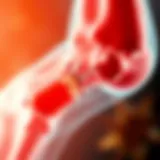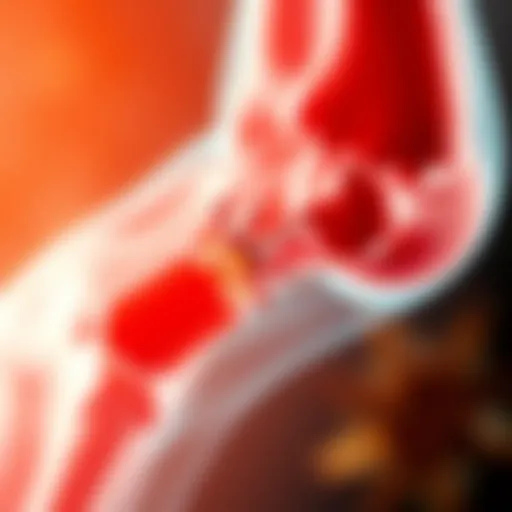Ginger's Impact on Blood Pressure Management


Intro
Key Concepts and Terminology
Definition of Key Terms
To establish clarity within this discussion, it is essential to define some key terms related to ginger and its influence on blood pressure:
- Hypertension: Hypertension, or high blood pressure, is a chronic medical condition characterized by elevated pressure in the arteries, leading to various health complications.
- Bioactive Compounds: These are naturally occurring compounds in foods that have beneficial effects on health. In ginger, such compounds include gingerol and shogaol.
- Complementary Approach: This term refers to the use of natural remedies alongside conventional medical treatments for improved health outcomes.
Concepts Explored in the Article
This article will cover several interconnected themes:
- The biochemical properties of ginger and their implications for blood pressure regulation.
- A review of traditional uses of ginger in various cultures as a remedy for health issues, including hypertension.
- Analysis of existing research that evaluates the effects of ginger on blood pressure levels, presenting both affirmative results and areas needing further investigation.
Findings and Discussion
Main Findings
Research on ginger's effect on blood pressure regulation suggests that components such as gingerol may possess vasodilatory effects. Vasodilation refers to the widening of blood vessels, which can reduce blood pressure. Several studies indicate that regular consumption of ginger could lead to improved blood circulation and a consequent decrease in blood pressure levels.
For instance, a study published in the Journal of Nutrition found that participants consuming ginger exhibited lower systolic and diastolic blood pressure readings after a period of supplementation. However, while there are promising findings, the methodologies and sample sizes in some studies vary significantly, indicating a need for standardized research practices to confirm these effects comprehensively.
Potential Areas for Future Research
Future research could greatly enhance understanding of ginger's role in blood pressure regulation by exploring the following areas:
- Long-term effects of ginger supplementation onHypertension and overall cardiovascular health.
- Mechanisms underlying ginger's impact on vasodilation and its interaction with medications for blood pressure.
- The optimal quantity and form of ginger (fresh, dried, or extract) for achieving health benefits.
Overall, ginger represents a potential complementary approach in managing blood pressure, but further rigorous studies are necessary to solidify its efficacy and guide its application in clinical practice.
"The path to a deeper understanding of natural remedies like ginger in hypertension management must meld science with traditional use, leading to a holistic approach."
Prelims to Blood Pressure
Blood pressure is a critical aspect of human health. It refers to the force exerted by circulating blood against the walls of blood vessels. This measure is essential for maintaining proper blood flow throughout the body, supporting vital functions. Abnormal blood pressure levels can lead to serious health complications, including heart disease and stroke.
Maintaining optimal blood pressure is necessary for overall health. It ensures that organs receive adequate oxygen and nutrients while facilitating the removal of waste products. Uncontrolled high blood pressure, or hypertension, can damage blood vessels and hearts over time, leading to various chronic conditions. Conversely, low blood pressure might result in insufficient blood flow to critical organs, causing dizziness and fainting.
Understanding the dynamics of blood pressure regulation is crucial. Many factors influence blood pressure, including lifestyle choices, diet, and even genetics. This article focuses on how ginger, a traditional remedy, may play a role in managing blood pressure levels. It explores scientific insights alongside cultural practices to offer a comprehensive perspective.
Understanding Blood Pressure
Blood pressure is measured using two numbers: systolic and diastolic pressures. Systolic pressure occurs when the heart beats and pumps blood into the arteries. Diastolic pressure, on the other hand, occurs when the heart rests between beats. These measurements provide a snapshot of the force exerted on artery walls during both phases. Normal blood pressure typically falls below 120/80 mmHg, while readings above this threshold may signal hypertension.
Factors like diet, stress, and physical activity can greatly affect blood pressure levels. Poor dietary choices, such as high sodium consumption, can lead to elevated blood pressure. In contrast, regular exercise and a balanced diet rich in fruits and vegetables can contribute to healthy blood pressure levels.
Key Factors Influencing Blood Pressure
- Diet: High salt intake increases blood pressure.
- Physical Activity: Sedentary lifestyles correlate with hypertension.
- Stress Levels: Chronic stress can lead to elevated blood pressure.
- Genetics: Family history plays a role in determining blood pressure trends.
By grasping these concepts, individuals and health practitioners can better address hypertension and its management.
Significance of Blood Pressure Regulation
Regulating blood pressure is vital not only for immediate health issues but also for long-term wellbeing. Many people underappreciate the impact of stable blood pressure on their daily lives. Correctly managing blood pressure can mitigate potential health risks, enhancing both quality and longevity of life.
The benefits of blood pressure regulation include:


- Reduced Risk of Heart Disease: Keeping blood pressure within a normal range lowers the risk of cardiovascular events.
- Prevention of Stroke: Proper regulation helps avert severe brain injuries caused by blood flow disruptions.
- Improved Kidney Function: Healthy blood pressure levels contribure to optimal kidney performance and filtration.
"Management of blood pressure is not just a medical issue; it is a lifestyle choice that influences every aspect of health."
Engaging in preventive measures is wise. Beyond medication, lifestyle modifications can effectively manage blood pressure. Diet, exercise, and natural remedies like ginger may contribute helpful effects. Understanding ginger's role in blood pressure regulation yields valuable insight into comprehensive health strategies.
Ginger: A Scientific Overview
In the context of blood pressure regulation, understanding the scientific foundation of ginger is crucial. Here, we will explore the unique botanical characteristics of ginger and identify its active compounds. These elements not only highlight ginger’s potential health benefits but also provide insight into how it may influence vascular health and overall blood pressure levels. With a growing interest in natural remedies, an in-depth examination of these aspects is essential for both practitioners and individuals interested in this area of health management.
Botanical Characteristics
Ginger, scientifically known as Zingiber officinale, is a flowering plant belonging to the family Zingiberaceae. Its rhizome, commonly referred to as ginger root, is widely used for culinary and medicinal purposes. The plant typically grows in warm, humid climates. Characteristics include:
- Growth Form: Ginger plants can reach up to a meter in height, with narrow green leaves that are lanceolate in shape.
- Flowering: The ginger plant produces unique flower clusters that are small and often overlooked compared to the rhizomes, which are the primary source of ginger used in cooking and herbal remedies.
- Harvesting: The rhizomes are harvested before the plant blooms, ensuring that the root is tender and flavorful. Different harvesting times can affect the potency and flavor profile of the rhizome.
These botanical features illustrate the resilience and adaptability of ginger, making it a valuable plant in diverse environments. The cultivation and sourcing of ginger can influence its quality, which is an important factor when considering its therapeutic potential.
Active Compounds in Ginger
Ginger contains a variety of bioactive compounds that contribute to its health benefits. Some of the most significant include:
- Gingerol: This is the primary compound responsible for ginger's distinct flavor and aroma. Studies suggest that gingerol has anti-inflammatory and antioxidant properties, which may benefit cardiovascular health.
- Shogaol: Formed when ginger is dried or cooked, shogaol also exhibits strong antioxidant effects and may enhance blood circulation.
- Paradols: Another group of compounds that have been linked to anti-inflammatory effects, offering additional support in managing blood pressure.
Research indicates that these active compounds work synergistically to promote health. For example, gingerol and shogaol can help relax blood vessels, thereby potentially lowering blood pressure. This mechanism underscores the importance of ginger in dietary considerations for those looking to manage their blood pressure naturally.
The myriad compounds present in ginger demonstrate its potential as a functional food, crucial for health strategies targeting hypertension.
To summarize, a clear understanding of ginger's botanical characteristics and active compounds lays the groundwork for its exploration in blood pressure regulation. Each aspect contributes to a comprehensive view of its health relevance, helping individuals to make informed choices regarding dietary supplementation.
Traditional Uses of Ginger
The traditional uses of ginger provide a rich context for understanding its potential benefits in blood pressure regulation. For centuries, ginger has been employed in various cultures, not just as a culinary ingredient but also for its medicinal properties. As natural remedies grow popular among individuals seeking alternatives to pharmaceuticals, the traditional applications of ginger become increasingly relevant in discussions around health management. By examining the historical narrative and cultural significance of ginger, readers can appreciate its longstanding association with wellness.
Historical Context
Ginger’s history dates back thousands of years, with origins in Southeast Asia. Ancient texts in Chinese medicine cite ginger as an important herb, used to treat various ailments, including digestive issues and respiratory infections. In Ayurveda, the traditional Indian system of medicine, ginger is known for its warming properties, often utilized to stimulate circulation and alleviate symptoms of nausea.
Throughout history, traders spread ginger across continents, and its use permeated diverse cultures. By the Middle Ages, in Europe, ginger became a staple spice that amalgamated into culinary practices and traditional remedies. Even today, historical recipes and herbal formulations incorporate ginger.
Cultural Practices Involving Ginger
Ginger's integration into cultural practices highlights its versatility and importance. In different regions, its applications vary:
- Asia: In countries like Japan and China, ginger is typically consumed fresh or pickled. It is an essential component in dishes such as sushi and stir-fried meals, believed to enhance digestion and overall health.
- India: Ginger tea is a common remedy for colds and flu, often blended with honey and lemon. Many Indian families include ginger in their daily diets not just for flavor but for its potential health benefits.
- Western Cultures: Ginger ale or ginger tea serves as a comforting beverage for stomach ailments. In recent years, the resurgence of interest in herbal remedies has led to a revival of ginger's use in natural health circles.
"Ginger remains an integral part of traditional health practices, bringing together culinary delight and healing properties."
The Evidence Linking Ginger and Blood Pressure
The link between ginger and blood pressure regulation is an important area of investigation within this article. Ginger has been valued not just for its culinary uses but also for its potential health benefits. Understanding the evidence that supports ginger's impact on blood pressure can help individuals and health practitioners make informed decisions about its inclusion in dietary strategies. This section focuses on the clinical studies that underpin this relationship and explores the intricate biochemical mechanisms involved.
Review of Clinical Studies
Clinical research indicates that ginger may play a significant role in managing blood pressure levels. Several studies have investigated how ginger intake may influence hypertension. The results generally suggest a promising relationship, although outcomes can be mixed depending on various factors, such as the population studied and dosage used.
- Control Studies: A notable randomized controlled trial examined the effects of ginger supplementation on high blood pressure patients. Participants who consumed ginger showed a statistically significant decrease in blood pressure compared to those taking a placebo.
- Systematic Reviews: Some reviews aggregated findings from multiple studies and reinforced the idea that regular ginger consumption correlates with lower blood pressure. These studies point out that even small doses of ginger can have an anti-hypertensive effect.
- Ethnic Variations: Additional studies consider ethnic variations in responses to ginger. For instance, populations traditionally consuming ginger may experience different benefits compared to those who seldom use it. This reinforces the need for further investigations into optimal dosages and forms of ginger.
"Research shows ginger may provide a natural method to aid in blood pressure management, though individual responses vary."
Biochemical Mechanisms


Biochemical understanding is crucial in decoding how ginger affects blood pressure regulation. Researchers have identified several mechanisms that illustrate the potential of ginger in promoting vascular health.
Antioxidant Properties
Antioxidant properties of ginger play a prominent role in hypotensive effects. Ginger contains bioactive compounds like gingerol and shogaol, known for their ability to neutralize reactive oxygen species (ROS). The high level of oxidative stress is a contributing factor to hypertension and cardiovascular diseases. By combating oxidative stress, ginger's antioxidants can help preserve endothelial function, which is vital for regulating blood pressure.
- Key Characteristic: Ginger's capacity to reduce oxidative stress effectively stands out as a significant feature. This antioxidant activity lowers inflammation and may improve nitric oxide pathways that enhance blood flow.
- Unique Feature: The unique feature of ginger's antioxidants is their ability to operate in both fat-soluble and water-soluble environments, making their action versatile in the body. This versatility can be advantageous, as oxidative stress occurs in various bodily systems.
Anti-inflammatory Effects
The anti-inflammatory effects of ginger also contribute to its role in managing blood pressure. Chronic inflammation is closely linked with hypertension. Ginger’s bioactive compounds help to mitigate inflammatory markers in the bloodstream, which can aid in maintaining normal blood pressure levels.
- Key Characteristic: One key characteristic of ginger's anti-inflammatory effect is the inhibition of cyclooxygenase and lipoxygenase enzymes, which are often implicated in inflammatory processes.
- Unique Feature: The unique aspect of its anti-inflammatory effects is the dual action where it not only helps reduce inflammation but also supports metabolic processes that can lead to better cardiovascular health. This duality makes ginger a favorable choice in dietary strategies for hypertension management.
Mechanisms of Action
Understanding the mechanisms of action for ginger in the context of blood pressure regulation is critical. It provides insight into how this natural remedy may exert its effects within the body. By examining the underlying biological processes, we can better appreciate not only the potential benefits of ginger but also considerations for its use in health management. This section discusses how ginger can influence vascular health and the circulatory system, contributing to its overall impact on blood pressure levels.
Impact on Vascular Function
Ginger has been shown to contribute positively to vascular function. One key aspect is its ability to enhance endothelial function. The endothelium lines the blood vessels and plays a critical role in maintaining vascular health. When endothelial function is impaired, it can lead to increased blood pressure and other cardiovascular issues.
Research indicates that ginger improves nitric oxide production. Nitric oxide is a vasodilator, meaning it helps relax blood vessels. This relaxation reduces resistance within the vascular system, ultimately lowering blood pressure.
Additionally, ginger possesses anti-inflammatory properties. Chronic inflammation can damage the endothelium and lead to hypertension. By reducing inflammation, ginger may help preserve endothelial integrity and function.
Some studies have described how ginger can influence the levels of various hormones involved in blood pressure regulation, such as angiotensin II. Lowering angiotensin II activity can lead to vasodilation and a decrease in blood pressure. Furthermore, ginger may reduce the synthesis of certain pro-inflammatory cytokines, enhancing overall vascular health.
Effects on Circulatory System
The circulatory system's response to ginger is closely tied to its impact on blood pressure. Ginger's composition includes compounds that help improve blood flow and circulation. Increased blood flow can enhance oxygen delivery to tissues, promoting overall cardiovascular health.
Moreover, ginger may help in the management of arterial stiffness. Stiff arteries are a common issue among those with high blood pressure as they can exacerbate the condition. Ginger’s ability to improve vascular elasticity is of great interest. Enhanced elasticity allows arteries to expand more efficiently with each heartbeat, alleviating pressure.
Ginger also exhibits antioxidant properties. Free radicals can damage blood vessels and contribute to hypertension. By mitigating oxidative stress, ginger can support the health of the circulatory system and help prevent hypertension-related complications.
In summary, the mechanisms through which ginger affects blood pressure are multifaceted. By influencing vascular function and supporting circulatory health, ginger may serve as a beneficial addition to blood pressure management strategies. Understanding these mechanisms can inform future research and practical applications in using ginger for health benefits.
Practical Applications of Ginger for Blood Pressure
Understanding how to apply ginger in daily life can contribute to managing blood pressure levels effectively. Its benefits stretch beyond traditional uses and into a realm supported by scientific research. By incorporating ginger in various forms, individuals might find a natural method to support their cardiovascular health.
Ginger Consumption Methods
Fresh Ginger
Fresh ginger is often praised for its potent health benefits. It contains high levels of bioactive compounds, primarily gingerol, which have been shown to improve circulation. This is crucial for individuals combatting high blood pressure as better circulation can lead to lower blood pressure levels. Fresh ginger can be easily added to meals or smoothies, making it a practical option for many.
The key characteristic of fresh ginger is its strong flavor and the range of nutrients it provides. It is not just popular but also versatile, allowing it to be a beneficial addition to both savory and sweet dishes. One unique feature is its fresh, spicy aroma, which can enhance the sensory appeal of food. However, some individuals might find its pungent taste challenging, necessitating moderation when incorporating it into their diet.
Ginger Tea
Ginger tea is a widely consumed beverage that uses ginger as a primary ingredient. This drink can aid in reducing stress and promoting relaxation, which is essential for managing blood pressure levels. The warmth of the tea provides both physical and mental comfort, which can indirectly influence blood pressure positively by lowering stress.
One notable characteristic of ginger tea is its simplicity in preparation. It can be made easily at home, making it a convenient choice for those seeking natural remedies. The unique feature of this preparation is the infusion process, where the flavors and beneficial elements of ginger are effectively extracted. While ginger tea is generally safe, its concentrated nature may cause some gastrointestinal discomfort in sensitive individuals, particularly when consumed in excess.
Ginger Supplements
Ginger supplements offer a standardized way to consume ginger, ensuring a consistent dosage of its active compounds. These supplements can be an excellent option for those who find it difficult to incorporate enough ginger into their diets. They can aid in achieving the desired health benefits without the effort of meal preparation.


The key characteristic of ginger supplements is their convenience, allowing for precise dosing without needing to prepare food or drinks. A unique feature is the ability to choose between capsules, powders, and extracts, providing flexibility in consumption methods. However, a potential disadvantage is the less pronounced flavor profile compared to fresh ginger or tea, which can be less appealing for those who enjoy the taste of ginger. Moreover, it is crucial to choose high-quality supplements to avoid fillers and ensure the efficacy of the product.
Dosage Considerations and Guidelines
Determining the proper dosage of ginger is essential for maximizing its benefits while minimizing any possible side effects. Research suggests that consuming between 1 to 3 grams of ginger daily can be effective for health benefits, including blood pressure regulation. Individuals considering higher dosages should consult with a healthcare professional to avoid potential interactions with medications or adverse effects.
In summary, whether it is through fresh ginger, ginger tea, or supplements, practical applications of ginger can provide varied methods to support better blood pressure regulation. Each method has its distinct advantages and considerations, catering to different preferences and lifestyles.
Potential Risks and Considerations
The exploration of ginger in the context of blood pressure regulation requires an examination of its potential risks and considerations. While ginger possesses various health benefits, it is essential to acknowledge that consumption may lead to certain adverse effects and interactions, especially when integrated with other treatments. This section addresses these components, allowing individuals to make informed decisions regarding ginger as a natural remedy for hypertension.
Adverse Effects of Ginger
Ginger is generally regarded as safe for most people when used in moderate amounts. However, excessive consumption can lead to unwanted side effects. Common adverse reactions include:
- Gastrointestinal Issues: Some individuals may experience stomach upset, heartburn, or diarrhea after consuming ginger, particularly in large quantities.
- Allergic Reactions: While rare, allergic reactions to ginger can occur, manifesting as skin rashes, itching, or respiratory difficulties in sensitive individuals.
- Blood Thinning: Ginger has antiplatelet properties, which means it may increase the risk of bleeding when consumed in excess or when taken with other blood-thinning medications such as aspirin or warfarin.
It is crucial for individuals, especially those with existing health conditions, to monitor their ginger intake and observe any symptoms that arise. Consulting with a healthcare provider before introducing ginger into their diet is advisable, ensuring a balanced approach to health management.
Interactions with Medications
The interaction of ginger with various medications is a significant consideration for those looking to integrate it into their regimen. Here are key points regarding its interactions:
- Anticoagulants and Antiplatelet Drugs: As mentioned earlier, ginger can enhance the effects of these medications, leading to a heightened risk of bleeding. Individuals on blood-thinning medications should use caution and consult a healthcare professional.
- Blood Pressure Medications: Ginger may have an added effect on blood pressure. While this could be beneficial for regulation purposes, it could also exacerbate hypotensive effects when taken alongside medications aimed at lowering blood pressure.
- Diabetes Medications: Ginger has been shown to lower blood sugar levels. Therefore, individuals taking diabetes medications should be particularly cautious. Consuming ginger in conjunction with these treatments may result in hypoglycemia.
Understanding these interactions is vital for anyone considering ginger as a complementary approach to blood pressure management. Regular monitoring and communication with healthcare professionals can mitigate potential risks, promoting a cautious yet beneficial incorporation of ginger into one’s lifestyle.
"Natural remedies have their place in health management, but awareness of potential risks is crucial for safe use."
Future Research Directions
Identifying Gaps in Current Knowledge
While there is a growing interest in the benefits of ginger, substantial gaps remain in our understanding. Current studies often focus narrowly on the effects of ginger alone, neglecting the context of its consumption and interaction with other dietary factors. For example, the specific dosasges of ginger and the timing of consumption in relation to meals are seldom examined. Furthermore, the variability in individual responses to ginger due to genetic or lifestyle factors is still not well addressed.
Key gaps that warrant exploration include:
- Longitudinal Studies: Most existing research is short-term, lacking insights into long-term effects of ginger consumption on blood pressure.
- Bioavailability Research: How well do the active compounds in ginger absorb and affect blood pressure in diverse populations?
- Combined Dietary Effects: What are the interactions between ginger and common medications or foods that can alter its effectiveness?
Emerging Studies and Trials
Recently, a number of emerging studies are focusing on the effects of ginger and its active compounds in various populations. These trials aim to address the gaps identified and further substantiate ginger’s role in blood pressure regulation. Some aspects of these studies include:
- Randomized Controlled Trials (RCT): RCTs are being designed to measure the specific impacts of ginger on hypertensive patients over time.
- Diverse Population Testing: Research is expanding to include various demographic groups, considering factors such as age, sex, and pre-existing health conditions.
- Mechanistic Studies: New trials are investigating the biochemical pathways through which ginger might affect vascular health, particularly its impact on inflammation and oxidative stress.
This landscape of emerging research signals a burgeoning interest in the therapeutic potential of ginger, increasing the validity of its use in blood pressure management. As studies evolve, they contribute to a more nuanced understanding of ginger as a complementary approach to addressing hypertension.
End
In concluding this exploration of ginger's role in blood pressure regulation, we can observe several compelling aspects that underscore its significance. First, ginger's historical presence in various cultures as a remedy for numerous ailments highlights a long-standing trust in its healing properties. This article provides a scientific foundation for these traditional beliefs, linking ginger's active compounds to specific biochemical mechanisms that may influence blood pressure.
Summary of Findings
Through a careful review of current clinical studies and biochemical research, several findings have emerged:
- Active Compounds: Ginger contains bioactive components like gingerols and shogaols that exhibit antioxidant and anti-inflammatory properties, contributing to vascular health.
- Clinical Research: Numerous studies have shown that ginger may lead to reductions in both systolic and diastolic blood pressure among individuals with hypertension.
- Mechanisms of Action: The effects on blood pressure regulation can be attributed to improved endothelial function and reduced oxidative stress in the circulatory system.
These findings suggest that ginger could play a crucial role as a complementary approach in managing blood pressure levels, alongside conventional treatments.
Implications for Health Practices
The implications for health practices are vital, especially for health practitioners and individuals looking for natural options to improve their hypertension management. Considering ginger as a supplementary strategy, professionals in the health field should take into account the following:
- Incorporation into Diet: Encouraging patients to include various forms of ginger in their diets—whether fresh slices, tea, or supplements—could enhance overall health outcomes.
- Personalization of Treatment: Tailoring ginger consumption based on individual patient response and preferences can increase adherence and efficacy.
- Monitoring Blood Pressure: Practitioners should advise continuous monitoring of blood pressure when introducing ginger or any new supplement, assessing its impact and making informed adjustments in treatment plans.
In summary, as research continues to grow, understanding ginger’s benefits and mechanisms can inform current health practices, leading to an integrative approach to hypertension management.







